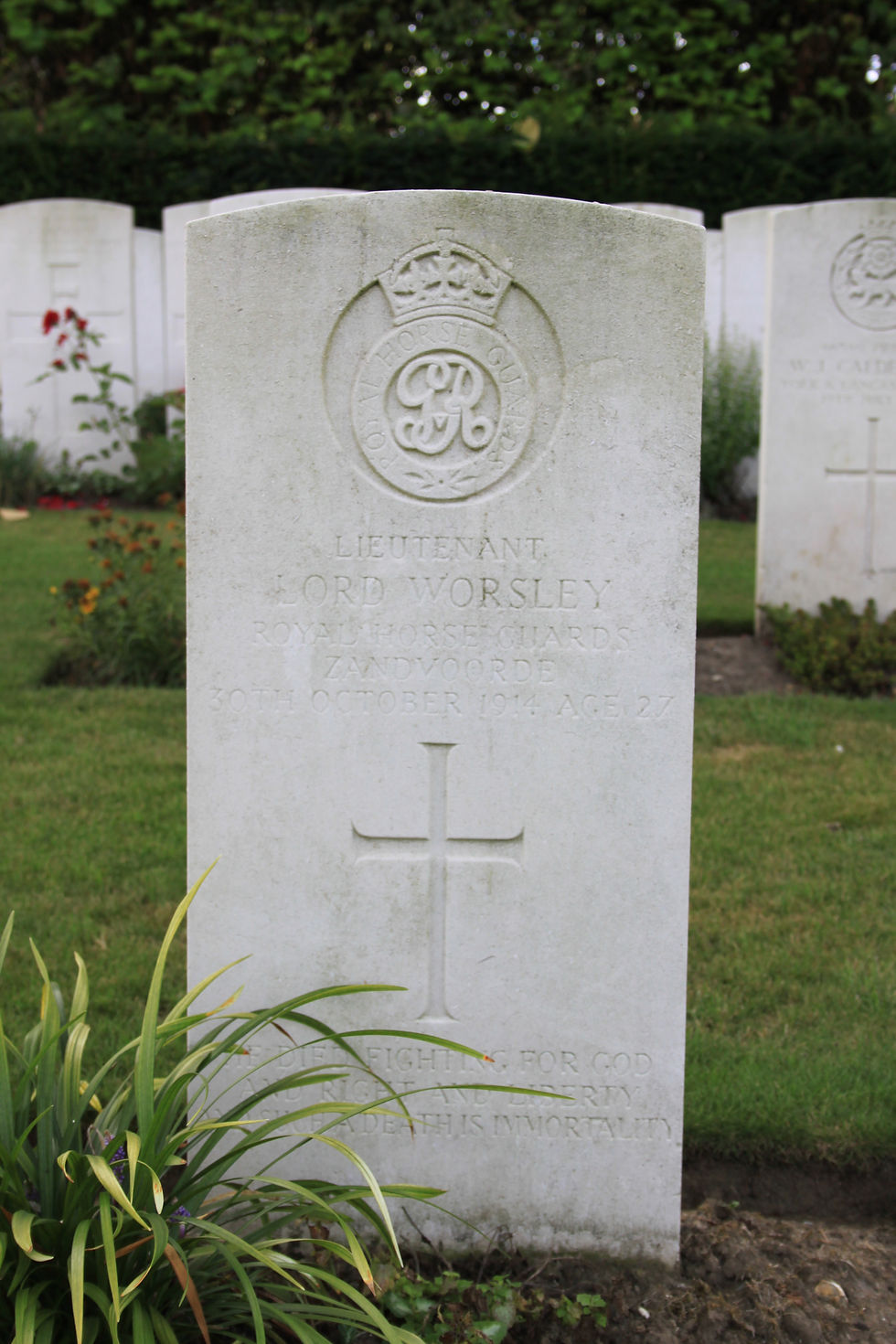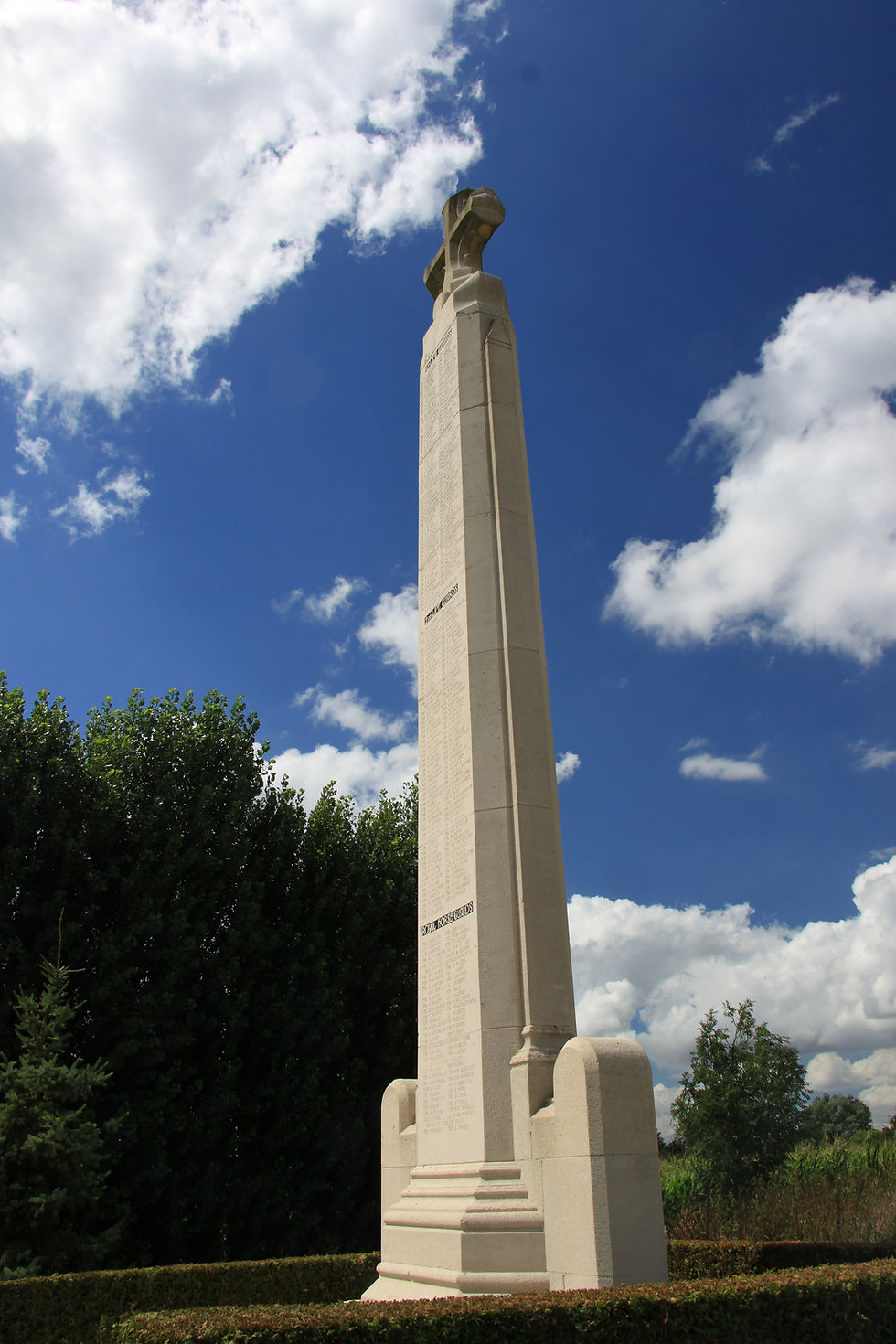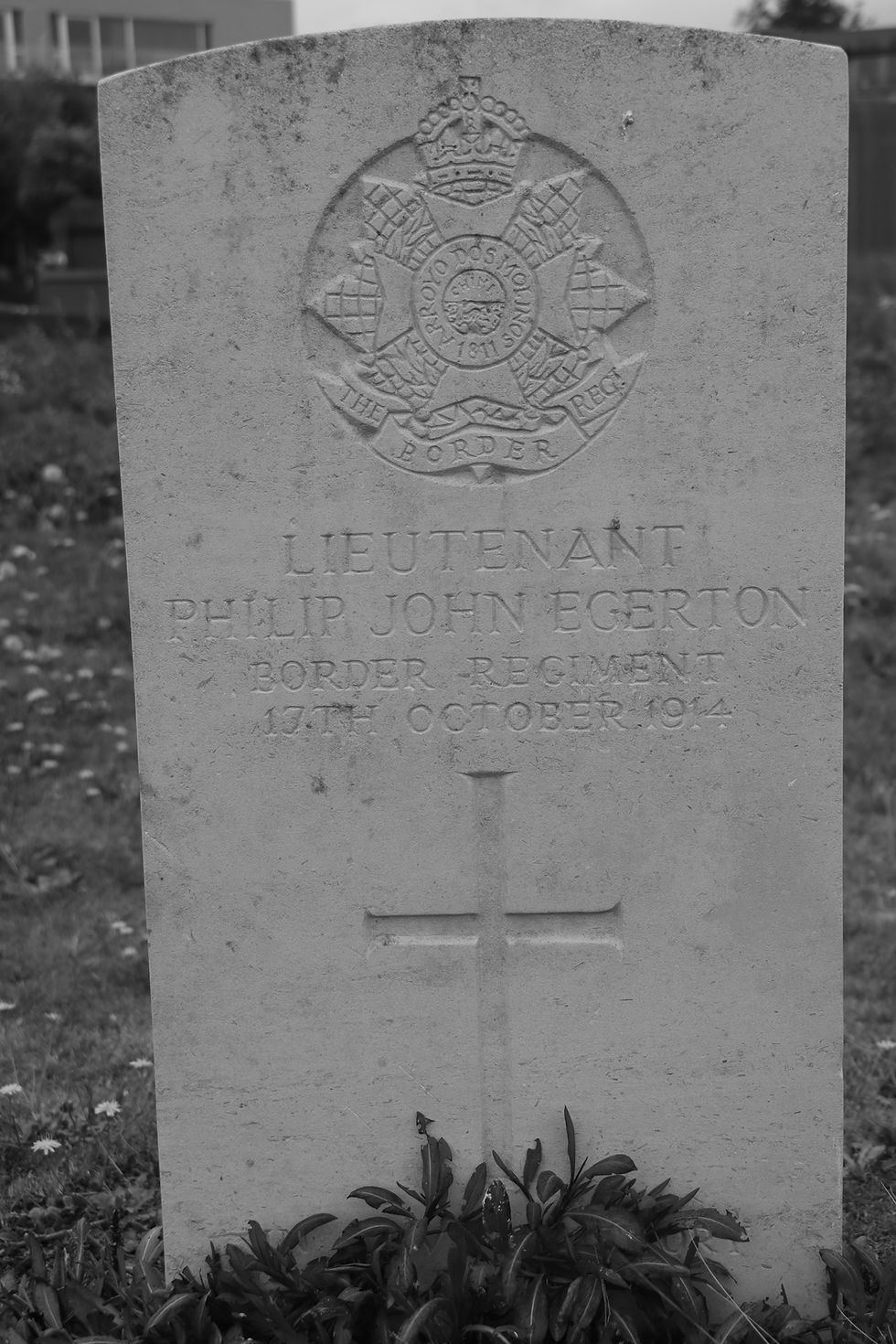Ypres Town Cemetery Extension
- Admin
- Dec 27, 2021
- 8 min read
Updated: Jan 26, 2025

There are many British Military Cemeteries in the Salient where you can seek out the time for quiet contemplation of the sacrifice made. This is one of them. Despite the cemetery’s close proximity to the Menin Gate, it lies in the junction in the road between the Menin Road and the road leading to Zonnebeke, visitors are few and far between.
The Ypres Town Cemetery Extension, on the east side of the town cemetery, was begun in October 1914 and was used until April 1915, and on two further occasions in 1918.

Lieutenant Lord Charles Sackville Pelham, Lord Worsley
'C' Squadron, Machine Gun Section, Royal Horse Guards. Killed in action 30 October 1914, age 27. Grave II.D.4. Son of Charles Alfred Worsley Pelham, 4th Earl Yarborough and Marcia Countess of Yarborough, of Brocklesby Park, Lincolnshire. On 31 January 1911, he married Alexandra Mary Freesia Vivian, daughter of Hussey Vivian, 3rd Baron Vivian and the former Louisa Alice Duff, and sister-in-law of then General Douglas Haig.
The Action on 30 October 1914
The village of Zandvoorde situated on a ridge south-east of Ypres was a critical sector of the line and was defended by elements of the 7th Cavalry Brigade, who were dismounted and being used as infantry, and the 1st Battalion Royal Welsh Fusiliers. To the left were 7th Division. They were opposed by the German 39th Division who were attempting to take the ridge and the road to Zillibeke which would open the way to Ypres. The Household Cavalry had very rudimentary trenches badly sited on a downward slope just south of the Zandvoorde-Tenbrielen Road. On the left flank in trenches close to the road was ‘C’ Squadron, 1st Life Guards and commanded by Captain, the Lord Hugh Grosvenor, and they had a commanding view of the area however, as their positions were on a down-ward slope they were easily visible to the Germans. This was to prove fatal as events unfolded. In the centre of the ‘C’ Squadron’s trench line was the machine -gun section commanded by Lieutenant Lord Charles Sackville Pelham Worsley. He had been ordered to stay behind with his machine-gun when this section of the line was relieved by the Life Guards, as the Life Guards had one of their machine-guns out of action. The German onslaught when it came at 6am on the morning of 30 October was ferocious. The Germans opened a devastating artillery barrage of 260 guns focused on the Cavalry positions. At 7.30am the German 39th Division plus three Jager battalions attacked the British lines. The hopelessly thin British lines gave way, with the Cavalry positions being blown in and very quickly overrun. This allowed the Germans to now enfilade the right flank of the 7th Division and to obliterate the 1st Royal Welsh Fusiliers. At 10am orders were issued to withdraw however, they did not reach the two squadrons of cavalry on the left flank and they suffered almost complete annihilation with only ten men getting back safely. Worsley was last seen directing the fire of his machine-gun as shells exploded around his position. He was listed amongst the missing along with Lord Grosvenor. The Germans now occupied the ridge and the village of Zandvoorde and moved forward to Klein Zillibeke.

Efforts to find his burial place
News of Lord Worsley being missing was passed onto the HQ of General Haig, then commanding 1st Corps. He was related to Worsley by marriage and it was said that he was distressed to hear the news. Lord Worsley was officially declared missing on 7 November 1914 and it was announced in January 1915 that he had been killed. A German officer, Oberleutnant Freiherr von Prankh, had found the body of a British officer lying in a trench and upon examining the body had identified him as a cavalryman and a Lord. He gave instructions that the dead man’s personal effects were to be collected, he intended to pass these onto the authorities to return to the next of kin, and he arranged a burial party. However, Prankh was killed two days later and the personal effects of Lord Worsley were lost forever. In July 1924, Lord Worsley’s identity disc, which had been handed in by a Hauptman Fischer, of Infantry Regiment 5/171 and later killed in the War, was found attached to a death list of a German Sanitary Company along with a statement that no other effects had been found. The identity disc was handed over to the family. During the War, the Worsley family had made use of their contacts via the War Office and diplomatic channels in Holland and the American Embassy in Berlin, and had obtained a map of the location of Lord Worsley’s grave site at Zandvoorde. In December 1918, Colonel A W James M.C., a family friend had been given the map by Lady Yarborough, Lord Worsley’s mother, and on the second attempt he found the grave. The Germans had marked the grave with a rough cross, the cross piece of which had fallen off in the intervening years. Colonel James marked the spot with stones and returned to Zandvoorde where he commissioned a simple cross with the words ‘Lord Worsley, RHG, Oct.30th, 1914’. In January 1919, Colonel James and Sackville Pelham, Lord Worsley’s brother returned to the grave and placed the new marker. They found the cross piece of the German marker and this, along with the upright piece, now hangs above Lord Worsley’s sword in Brocklesby Church in Lincolnshire. In 1921, Lady Worsley, after correspondence with various government agencies, purchased the land on which her husband’s body lay. As part of the concentration of single graves the body was exhumed in 1921, after permission had been given by the Worsley family, and reburied in Ypres Town Cemetery Extension.
Hooge Chateau 31 October 1914
In Plot III, Row AA are the graves of some of the staff of General Haig’s 1st Corps who were in conference in Hooge Chateau, which was located on the Menin Road at the Hamlet of Hooge, and was being used as the joint HQ for the British 1st and 2nd Divisions on 31 October 1914. Major-General’s Lomax and Munro, General Officers commanding 1st and 2nd Divisions respectively, where in conference there when at 1.15pm the Germans laid down a heavy barrage registering a direct hit on the Chateau Annex. A number of officers were killed, General Munro was stunned and in a state of shock and General Lomax was seriously wounded, dying in England in 1915. With the commands in chaos at a critical juncture in the First Battle of Ypres, General Haig took command and reorganised the command of both Divisions.

The casualties from the shelling in Plot III, Row AA are: Grave 1 – 20630 Gunner W Marchant. 35th Heavy Battery, Royal Garrison Artillery. He is proof of the IWGC policy of equality in death amongst all ranks. Gunner Marchant died on 31 October with the other officers in this row. What is his connection to the events that day, well if we look at another casualty, not in the Extension, but buried in the military plot by the far boundary wall. Grave E.2.14 Captain Graham Percival Shedden, 35th Heavy Battery, Royal Garrison Artillery, age 28, died from wounds received in the direct hit on the Chateau. Son of George and Alice Shedden, of Spring Hill, East Cowes, Isle of Wight. It may well have been that Gunner Marchant was his batman or driver or maybe even both. Grave 2 – Lieutenant-Colonel Arthur Jex Blake Percival, D.S.O.. Northumberland Fusiliers. Attached to 2nd Staff, General Staff. Age 43. Cross of the Legion of Honour. Son of the Rt. Revd. John Percival, Bishop of Hereford; husband of Cecil H Percival, of 57, Ovington St, Chelsea, London. Grave 3 – Major George Paley. Rifle Brigade. Attached 1st Division Staff, GSO2. Age 42. Son of William Victor Paley, of Freckenham, Suffolk; husband of Rose Mildred Bloomfield Paley, of Garroch, Dalry, Kirkcudbrightshire. Served in the Sudan and South African Campaigns. Grave 4 – Colonel Frederic Walter Kerr, D.S.O., Twice Mentioned in Despatches. 1st Battalion Gordon Highlanders, Attached as GSO1, 1st Division HQ. Age 47. Son of Admiral Lord Frederic Kerr and Lady Frederic Kerr (nee Maitland); husband of Lady Helen V. L. Kerr, of Lavender Cottage, Breamore, Salisbury. Grave 5 – Major Francis Maxwell Chenevix-Trench, Mentioned in Despatches. Attached as Brigade-Major, Royal Artillery 2nd Division Staff. Age 36. Son of Colonel C. Chenevix Trench (late R.A.); husband of Sibyl Bruce (formerly Chenevix Trench), of 11, Carlisle Mansions, Westminster, London. Grave 6 – Captain Rupert Ommanney, twice Mentioned in Despatches. Attached as GSO3, Royal Engineers, 2nd Division Staff. Age 36.


Grave D1.8 Lieutenant Philip John Egerton - Killed by friendly fire
1st Battalion Border Regiment attached 2nd, 20th Brigade, 7th Division. Age 32. Died 17 October 1914. Son of Hubert and Annie Egerton, of St. Michael's Lodge, Chislehurst. Served in the South African War. The Battalion was in the line around Kruiseeke on 16 October when, in the early hours of the morning, he was severely wounded by his own platoon when he lost his way and walked in front of the lines. He died on 17 October from his wounds.
Men and Women of the IWGC
In Plot III, Row A, are nineteen graves of the men and women of the IWGC later CWGC who died in retirement after giving years of service and dedication in looking after the graves of the fallen in the Salient.
The extension was designed by Sir Reginald Blomfield.
Cemetery Location
Ypres Town Cemetery is located 1 Km east of Ieper town centre, on the Zonnebeekseweg, connecting Ieper to Menen on the N345. From Ieper town centre the Zonnebeekseweg is located via Torhoutstraat and right onto Basculestraat. Basculestraat ends at a main crossroads, and the Zonnebeekseweg is the first left turning. The cemetery itself is located 300 metres along the Zonnebeekseweg on the right hand side of the road.
Burials
The Ypres Town Cemetery Extension was much increased after the Armistice when 367 graves were brought in from small cemeteries and isolated positions east and north of Ypres. Concentrated here post Armistice: La Premiere Borne located on the south side of the Menin Road which contained twenty British graves and was located near this cemetery. The Benedictine Convent Grounds at Ypres which had ten British burials from the fighting from July to September 1915. Four of the burials were moved here and six to the Ypres Reservoir Cemetery. Dragoon Camp located south of Potijze and contained the burials of twenty-four men from the 11th Battalion Argyll & Sutherland Highlanders killed in the fighting in June and July 1917. There are now 598 Commonwealth casualties of the First World War buried or commemorated in the extension. There are 137 unidentified burials and there are Special Memorials to 16 servicemen known or believed to be buried among them.
UK – 462
Australian – 13
Canadian – 15
South African – 1
India – 1
German – 2
Unnamed – 137
WWII – 42 UK & 1 Canadian
Second World War burials number 43, of which 13 are unidentified. During and after the fighting of May 1940, three civilian hospitals in the town, (Hopital de Notre Dame, the Clinique des Soeurs Noires and the Red Cross Hospital in St. Aloisius School, D'Hondstraat), cared for the wounded, and those who died were buried in the Town Cemetery Extension. Others buried on the battlefield were later brought in by the Ypres town services.






Comments